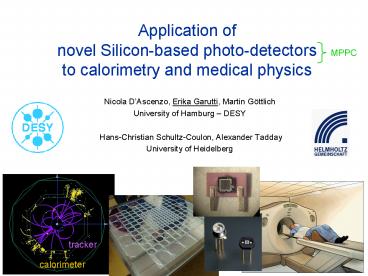Nicola D - PowerPoint PPT Presentation
1 / 13
Title:
Nicola D
Description:
Application of novel Silicon-based photo-detectors to calorimetry and medical physics MPPC Nicola D Ascenzo, Erika Garutti, Martin G ttlich University of Hamburg ... – PowerPoint PPT presentation
Number of Views:139
Avg rating:3.0/5.0
Title: Nicola D
1
Application of novel Silicon-based
photo-detectors to calorimetry and medical
physics
MPPC
- Nicola DAscenzo, Erika Garutti, Martin Göttlich
- University of Hamburg DESY
- Hans-Christian Schultz-Coulon, Alexander Tadday
- University of Heidelberg
2
The Multi Pixels Photon Counter(from Hamamatsu)
The MPPC is a multi-pixel avalanche photo-diode
operated in Geiger mode
Pixels (size mm2) Pieces Bias Dark Rate gt0.5pixels Dark Rate gt 1.5 pixels Gain (105)
400 (1x1) 5 76 V 220-250 kHz 9-10 kHz 7.4- 7.5
1600 (1x1) 5 78 V 50-60 kHz 0.05-0.1 kHz 2.6-2.7
3600 (3x3) 5 70 V 3.2-3.3 MHz 320-330 kHz 7.4-7.5
calorimetry application
Blue sensitive device ideal for direct r/o of
plastic scint. and crystals
PET application
3
MPPC characterization
intrinsic recovery time of MPPC 4 ns
measured at university of Shinshu (see talk S.
Uozumi, N41-4)
response curve to a 50ns long light signal
dynamic range artificially extended for long
signals due to fast recovery time MPPC 1600pix
has 6000 effective pix. for 50ns long
signal
4
Application in HEP calorimeters
- Task readout of active layers of
highly-segmented and granular calorimeter
Single calorimeter cell readout with SiPM
3x3 cm2 x 0.5 cm thick
see talk by F. Sefkow, N13-5
CALICE test beam CERN 2007
DATA
prototype active layer 100x100 cm2
- Requirements to photo-detector
- insensitive to B-field ( 5T)
- couple to organic scintillator (green/blue)
- low noise (dark rate cross talk above thresh.)
10-4 - detection eff. for Minimum Ionizing Particles
gt95 - ? light yield for MIP 10 pixels
- dynamic range 100-500 MIP
8000 SiPM operated
one MIP in 0.5 cm scintillator 10000 g (
WLS eff 200 g on SiPM)
5
Readout of plastic scintillators with MPPC
study driven by calorimetry applications for a
ILC detector
MIP
response to Ru106 source
3 cm
MPPC 1600 px
operation point
w WLS fiber
light yield pixels/MIP
RD direct r/o of scintillator tiles 3x3x0.5cm3
direct r/o
Vbias - Vbreakdown V
MPPC directly coupled
? LY sufficient for calorimeter application but
higher LY would allow thinner tiles (lower cost)
6
Readout of plastic scintillators with MPPC
MIP collection efficiency
noise spectrum
w WLS fiber
threshold at 1.5 pix dark rate lt 3 kHz
direct r/o
- ILC requirement
- dark rate lt 300 Hz
- MIP eff 95
- low but acceptable
MIP detection efficiency gt 97 for all r/o
combinations comparable with present status
400 px
Cut at 3 KHz
MIP spectrum
? larger dynamic range than at present
1600 px
7
Application in PET detectors
reduction of background
Task identify back-to-back scattered 511 keV
photons from ee- annihilation suppress
background and determine true line of response
Background events
remove combinatorial bg by ToF meas. Dt 500 ps
?
remove Compton-scattered g with good energy
resolution
8
Readout of scintillators crystals with MPPC
study driven by possible PET applications
- due to high MPPT gain (7.5x105) no amplification
needed ? simple readout - energy integral on VME QDC (Lecroy 1182)
- time resolution measurement 4 GHz Oscilloscope,
50 ps resolution (Textronix TDS7404B)
Lutetium OrthoSilicate from Heilger
Crystals Lutetium Fine Silicate from Lebedev,
Moskow
9
Readout of scintillators crystals with MPPC
Energy resolution
3x3 mm2 systems
1x1 mm2 system
LSO Crystal
MPPC 400
MPPC 3600
8 for LSO negligible
blue sensitivity
- LSO and LFS similar performance (within syst.
uncertainty of 2) - Result comparable with typical value for LSO
crystals PMT is DE/E 10 _at_ 511 keV
! after 4 months of test E resolution 132 ?
degradation of MPPC package or crystal surface ?
10
Issue of MPPC saturation
3600 pix. MPPC coupled to 3x3x15 mm3 LSO crystal
QDC spectrum
scope signal
- integral of 511 keV g signal 2000 p.e.
- ! but signal width 120 ns
- peak amplitude 400 p.e.
- below saturation estimated at gt 10000 pix. for
3600 pix. MPPC and 120 ns signal - but MPPC response non-linear everywhere (see
talk N18-2, K.C. Burr)
11
Readout of scintillators crystals with MPPC
Time resolution
- Procedure for time resolution measurement
- 0. store two waveforms from scope if amplitude
gt noise level ( 2mV or 10 pixels) - apply energy cut to exclude Compton background
- define a timing threshold to measure time
difference between signals
2.
tcut
two waveforms from the photon peak the voltage of
the two MPPC is tuned to give same response to
511 keV g
12
Time resolution result
fix threshold discr.
threshold pixels
- Npe 1 s of photon peak
- 10-15 of collected events used
- for lowest threshold FWHM 650 ps
- limited by scope noise
- no Jitter analysis package used for this
analysis
Photoelectric
Constant fraction discr.
13
Conclusions
- MPPC 400 and 1600pix very good candidates for
highly-granular calorimeter - - direct coupling to plastic scintillator
- - LYMIP 7 (10) p.e. with direct coupling (WLS
fiber mediated coupling) - - satisfactory MIP detection efficiency with
required noise cut - MPPC 3600 pixels excellent performance for PET
application - - E resolution comparable to PMT
- - t resolution lt 650 ps (noise limited)
- next step build 2 matrices of 6x6 MPPC
- with individual readout to test
- homogeneity, stability, reproducibility,
- calibration, multi-channel system
6x6 LFS crystals 3x3x15 cm3
6x6 MPPC 3600
we would like to thank Hamamatsu for providing
the MPPC samples for this study































